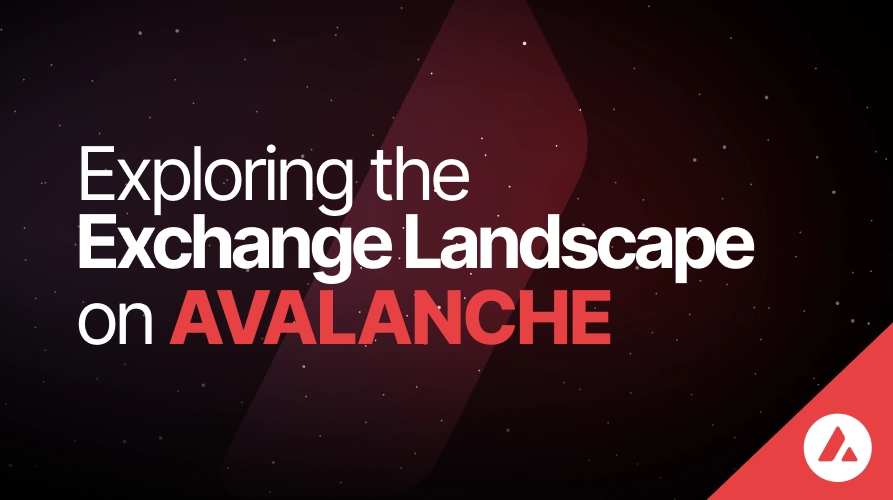Exploring the Exchange Landscape on Avalanche
Exploring the Exchange Landscape on Avalanche
May 31, 2023 / By Avalanche / 10 Minute Read

Avalanche provides the platform and tools for a variety of exchanges to deploy and be successful.
There is a whole universe of exchanges beyond the big centralized names. Some of the fastest and most innovative in the industry can be found on Avalanche. It is quite exciting to get to grips with the different exchange options available as users.
Three types of exchanges have gained significant traction recently:- Automated Market Makers (AMMs), Central Limit Order Books (CLOBs) and Fully Encrypted Exchanges (FEX). On Avalanche, there are a variety of exchange options available to DeFi enthusiasts.

Inline image from: Exploring the Exchange Landscape on Avalanche
Avalanche’s DEX-Factor
In the DEX category there are two types to run through, CLOBs and AMMs.
CLOBs (Central Limit Order Book)
First off, Central Limit Order Books or CLOBs are a key element of centralized exchanges (CEXs). Order books in these models have a major impact on how prices are determined and are a crucial component of efficient trading. Essentially, the price of a trade is determined by the lowest asking price, or sell order, on an order book, meaning the list of all the exchange’s limit orders.
The number of limit orders on both sides of the order book (meaning the buy and sell sides) has a direct impact on the liquidity of a trading pair. Greater liquidity results in narrower spreads between the ask and bid price, which in turn leads to more efficient trading at specific price ranges – contributing to less slippage. It's worth noting that market makers must maintain the order book and ensure liquidity.
Within DeFi, decentralized order-books or on-chain CLOBs are a rapidly growing area that aims to bring traditional CLOB design services to a decentralized, trustless environment, all on-chain.
What on-chain CLOBs bring to DeFi:
Transparent on-chain processing: All trades and transactions are recorded and verifiable on the blockchain, making it easier for traders to see the depth of the market.
Speed: order books can be generally fast for execution, because trades are executed instantly optimal for surfacing market prices and placing large orders.
Cost: offers low slippage trades as orders are constantly being matched
Decentralization: No intermediates, single entity or authority. Instead, powered by the protocol that maintains the order book. This helps to increase the security and resilience of the system.
Overall, they offer a more open and decentralized alternative to centralized CLOBs. As the DeFi space continues to grow, it's likely that technology will be supportive towards on-chain CLOBs continuing to evolve and compete with their centralized counterparts.
How CLOBs Work

Inline image from: Exploring the Exchange Landscape on Avalanche
Dexalot: Avalanche’s Standout CLOB
Dexalot, Avalanche's first decentralized CLOB, recently launched its own Subnet. The CLOB is experiencing significant transaction growth.
Dexalot is a first-mover in adopting Avalanche Subnets. It has a dual-chain architecture. In this dual-chain structure, a user is able to deposit tokens on the Avalanche C-Chain, and then mirrored to be traded on the Dexalot Subnet.
How Does Dexalot Work?
In general, CLOBs rebalance order book liquidity fast with minimal fees, Dexalot is not different. Ideal for users who want a cheaper and faster experience. Although this is hard to perfect on-chain, Avalanche facilitates the infrastructure necessary with Subnets

Inline image from: Exploring the Exchange Landscape on Avalanche
Why Can CLOBs Succeed on Avalanche?
Avalanche is ideal for Dexalot to run a fully efficient capable decentralized CLOB. These exchange types demand fast finality, low latency, low cost, and customizable VMs. Avalanche has all of these features thanks to its groundbreaking consensus and flexible architecture.

Inline image from: Exploring the Exchange Landscape on Avalanche
On-chain CLOBs provide a more open and decentralized alternative to centralized CLOBs, and on Avalanche, they can run efficiently with fast finality, low latency, low cost, and customizable virtual machines. Dexalot, the first CLOB3 on Avalanche, is able to reap in the benefits.
AMMs (Automated Market Maker)
Automatic Market Makers (AMMs) are a popular exchange type in the world of decentralized finance (DeFi) as they have revolutionized how we perceive exchanges. In essence, AMMs are a type of decentralized exchange (DEX) that function without an order book by utilizing liquidity pools.
At their core, AMMs with liquidity pools rely on the constant product market maker function, which sets the price for all swap pairs. A token swap involves the exchange of token types between two parties with self-custody of those tokens. The classic AMM model addresses two significant issues in DeFi, namely low transaction per second (TPS) and lower liquidity in asset pairs.

Inline image from: Exploring the Exchange Landscape on Avalanche
Source: finematics
In the traditional AMM model, liquidity is evenly distributed across all possible ranges in the price curve. Users can swap tokens by adding or removing them from a pool, and the ratio between the two tokens is recalculated accordingly. The price updates based on its position in the curve at that particular time.

Inline image from: Exploring the Exchange Landscape on Avalanche
Evolution of AMMs: Concentrated Liquidity
On Avalanche, AMM protocols have released their V2s, such as Trader Joe’s V2, called Liquidity Book, which has upgraded the traditional AMM model. They have introduced the concept of concentrated liquidity via liquidity bins, which allows users to select different ranges to deposit liquidity along the price curve.

Inline image from: Exploring the Exchange Landscape on Avalanche
Why is Trader Joe’s Liquidity Book Different?
A step in the right direction concerning capital efficiency for liquidity pools.
Concentrated liquidity is a major contrast to the traditional AMM model of x*y=k pools, where liquidity is always provided from 0 to infinity.
Liquidity Book keeps track of volatility through a Volatility Accumulator. This allows the pool to increase or decrease fees to help compensate liquidity providers for the Impermanent Loss they experience during volatile conditions. As a result, Liquidity Book's pools can offer trades with zero or minimal slippage, all while aiming to properly compensate users for the risks they take.
AMMs such as Trader Joe can be used as tools that educate DeFi users. Participants can be involved in various aspects of the exchange and experiment with different approaches. With these innovative protocols, AMMs have significantly changed the way we approach decentralized exchanges, and their impact will likely continue to grow.
Taking this all in, AMMs have revolutionized the world of decentralized finance by relying on liquidity pools instead of order books. Innovations such as Liquidity Book on Trader Joe have introduced the concept of concentrated liquidity, making liquidity pools more capital-efficient and compensating liquidity providers for some of the risks they take.
Avalanche’s FEX-Factor
FEX (Fully Encrypted Exchange)
Last but not least, the FEX, a new type of exchange with elements of a CEX and a DEX with its own unique blend for privacy. Avalanche is the first chain to introduce this new type of exchange with Enclave Markets.

Inline image from: Exploring the Exchange Landscape on Avalanche
Enclave Markets as an FEX includes:
Confidentiality: Trading within the secure enclave cryptographically ensures that no data or positions leak ahead of trade execution – preventing preferential treatment for insiders.
Decentralized custody: Users' assets are secured by a network of independent Attestors, similar to the Avalanche Bridge Wardens.
Centralized order book: Facilitates quick matching of buyers and sellers, enhancing liquidity and lowering trading costs.
No slippage: Minimizes the difference between expected and executed trade prices, benefiting traders.
Free from MEV: Prevents unfair profits by miners/participants manipulating or censoring transactions.
Free from preferential market access: Ensures equal opportunities for all users, irrespective of resources or information.
Where Does a FEX come up against other exchanges?

Inline image from: Exploring the Exchange Landscape on Avalanche
How is this achieved?
With two critical concepts: Secure Enclaves and Decentralized Custody. These concepts are new and essential for the industry, as they offer a new level of security and privacy to users' assets and transactions.
The exchange codebase runs within a Secure Enclave, which is a cordoned off section of the operating system that is designed to protect sensitive data and operations. Using advanced cryptographic techniques and hardware-level security measures, Secure Enclaves ensure that the data and operations are protected from unauthorized access, modification, and leaks.
Moreover, the concept of Decentralized Custody is unique in the cryptocurrency industry. Users can relinquish their custody, but neither the Enclave nor any single entity controls it. Instead, Decentralized Custody decentralizes the control of assets among a network of independent third parties, the "Attestor network." These third parties provide specialized key distribution functionalities and additional verification to confirm that no single entity has unilateral control of customer funds.
The combination of Secure Enclaves and Decentralized Custody offers security and privacy to users' assets and transactions. These concepts are essential to the cryptocurrency industry, as they address the inherent weaknesses of traditional centralized custody solutions and some of the issues in DEXs.
What Products Does Enclave Offer?
1) Enclave Cross
Fully encrypted crossing network that empowers everyone from institutions to retail traders to trade securely and protect their alpha.
Trade large buy or sell orders without broadcasting positions on-chain or to an order book.
Similar to institutional dark pools, the order book remains hidden from participants, with each trader only aware of their own positions. This protects your trade from front-running and MEV, and ensures optimal price execution. These networks are widely used in equities trading, and as more institutions enter the crypto space, the need for such products is becoming increasingly apparent.
2) Enclave Spot
Enclave Spot also operates within the FEX. Prices are determined by a traditional bid/ask model. This will resemble an exchange similar to that you get with a CLOB, but with the assurances that no one has an insider advantage within the secure enclave.
Enclaves FEX have emerged and cater for a new section of the market, to offer a level playing field for retail and institutional investors. Together, their spot and cross products could bring more entrants to this market.
Overall, the emergence of the FEX such as Enclave Markets is a promising development for the cryptocurrency industry. The combination of Secure Enclaves and Decentralized Custody offers a new level of security and confidentiality for users' assets and transactions, offering an alternative to the weaknesses of traditional centralized custody solutions and the drawbacks of some DEXs. Enclave Markets' Enclave Cross and Enclave Spot products can offer a range of trading options for both retail and institutional investors. If you're a user looking for a secure and confidential trading experience, it's time to explore the possibilities of a FEX like Enclave Markets.
Summary of the Exchange Landscape on Avalanche

Inline image from: Exploring the Exchange Landscape on Avalanche
Conclusion
Overall, the emergence of alternatives to centralized exchanges has created a breeding ground for new dApps. Avalanche has a plethora of options for enthusiasts, including CLOBs, AMMs and FEXs. On-chain decentralized CLOBs provide a more open and decentralized alternative to centralized CLOBs, and on Avalanche, they can run efficiently with fast finality, low latency, low cost, and customizable virtual machines. On the other hand AMMs have innovated with concentrated liquidity and find new capital-efficient ways to maintain their dominance in decentralized finance. More recently the emergence of the FEX offers something new to the market, with privacy and a more level playing field for all types of investors. All are available now on Avalanche which is molding into a hub of DeFi innovation.
About Avalanche
Avalanche is a high-performance blockchain platform designed for builders who need to scale. Engineered with a revolutionary three-part Layer 1 (L1) architecture, Avalanche is anchored by its Avalanche Consensus Mechanism, ensuring near-instant finality for transactions. The platform also features an open-source Layer 0 (L0) framework, enabling the seamless creation of interoperable Layer 1 blockchains with high throughput on both public and private networks.
Supported by a global community of developers and validators, Avalanche offers a fast, low-cost environment for building the next generation of decentralized applications (dApps). With its unique blend of speed, flexibility, and scalability, Avalanche is the preferred choice for innovators pushing the boundaries of blockchain technology.
Website | Whitepapers | Twitter | Discord | GitHub | Documentation | Forum | Telegram | Facebook | LinkedIn | Reddit | YouTube




